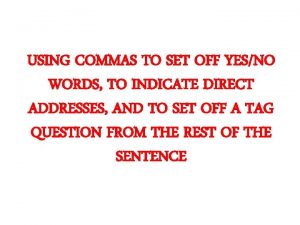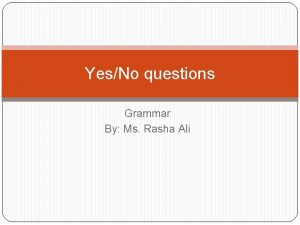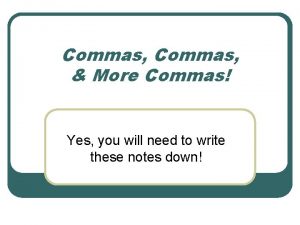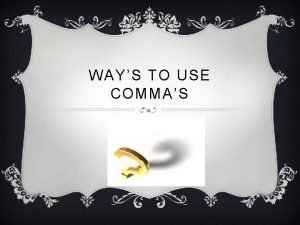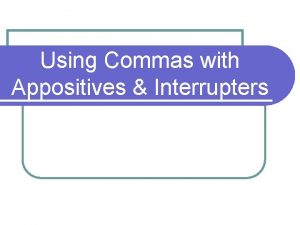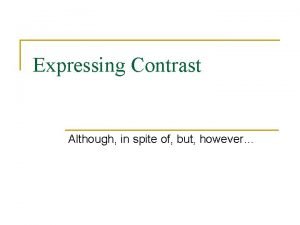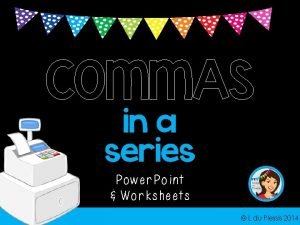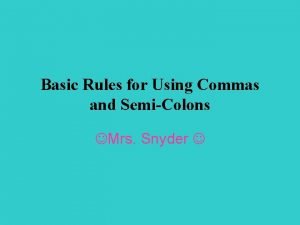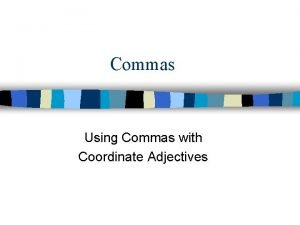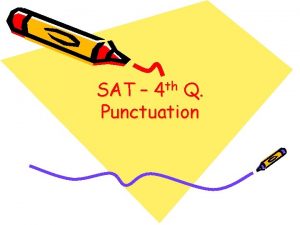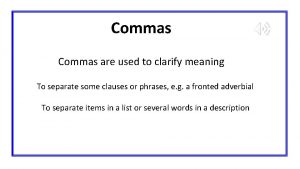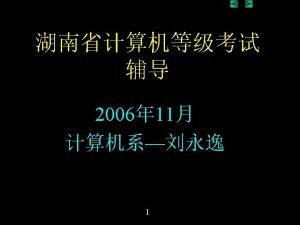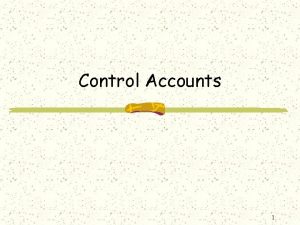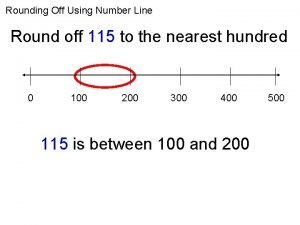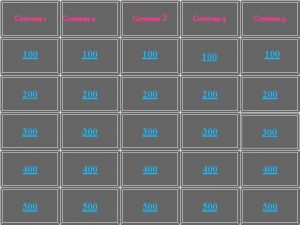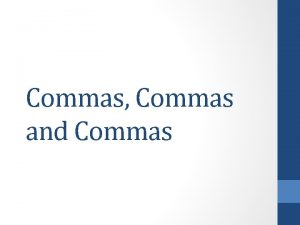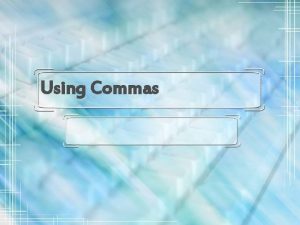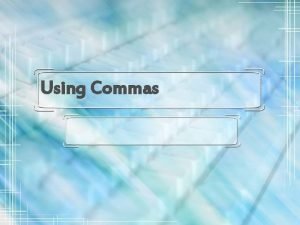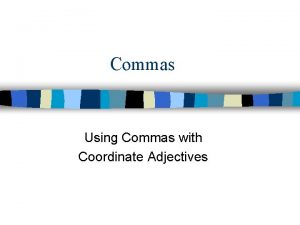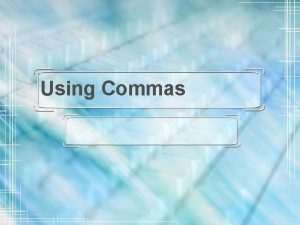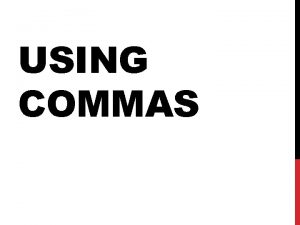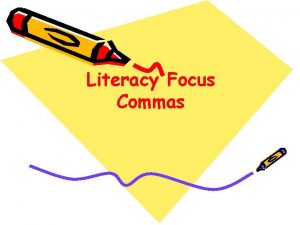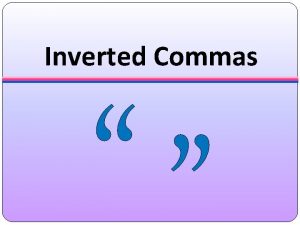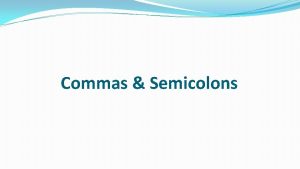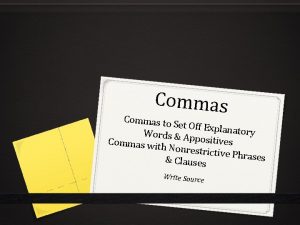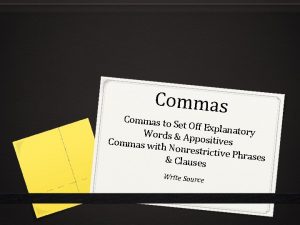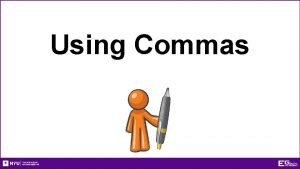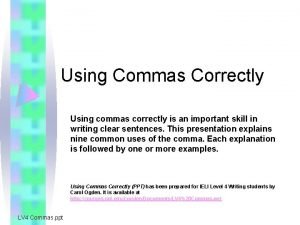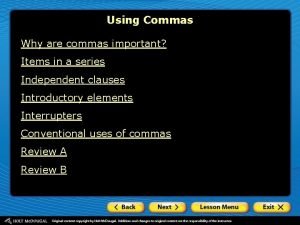USING COMMAS TO SET OFF YESNO WORDS TO





















- Slides: 21

USING COMMAS TO SET OFF YES/NO WORDS, TO INDICATE DIRECT ADDRESSES, AND TO SET OFF A TAG QUESTION FROM THE REST OF THE SENTENCE

Use a comma after certain introductory elements. • A comma is needed after yes, no, or any mild exclamation, such as well, why, gees, or gosh at the beginning of a sentence. Examples: Yes, you may borrow my bicycle. Why, it’s Lena! Well, I think you are wrong.

Use a comma after certain introductory elements. • Rewrite each sentence using the correct punctuation. – Yes you may have the last piece of apple pie.

Use a comma after certain introductory elements. • Rewrite each sentence using the correct punctuation. – No I don't understand your instructions.

Use a comma after certain introductory elements. • Rewrite each sentence using the correct punctuation. – Well do you want to be a squirrel instead?

Use a comma after certain introductory elements. • Rewrite each sentence using the correct punctuation. – No Marie doesn't want to wear a costume to the party.

Use commas to set off words that are used in direct address • A direct address is when the person speaking uses the name or a nickname for the person they are speaking to. Example: What time do you want to go to the game, Felix? • The name in the direct address is always set apart from the rest of the sentence by a comma or commas. If the name is at the end, as in the example above, the comma goes before the name. If the name is at the beginning of the sentence, the comma goes after the name. If the name is in the middle of the sentence, the name has a comma before and after. Examples: Felix, what time do you want to go to the game? What time, Felix, do you want to go to the game?

Use commas to set off words that are used in direct address • Rewrite each sentence using the correct punctuation. – Thad you were elected captain of the team!

Use commas to set off words that are used in direct address • Rewrite each sentence using the correct punctuation. – It is important Chelsea that you always wash your hands.

Use commas to set off words that are used in direct address • Rewrite each sentence using the correct punctuation. – Can you help me sir?

Use commas to set off words that are used in direct address • Rewrite each sentence using the correct punctuation. – Have a happy birthday Mom!

Use commas to set off words that are used in direct address • Rewrite each sentence using the correct punctuation. – You’re a great speller Winston so you might win the spelling bee.

Use commas to set off a tag question from the rest of the sentence. • A ‘tag-question’ is not a true question. It is used at the end of a statement sentence to get the confirmation from the listener or just to express one’s doubt. • A question sentence, on the contrary, is used to get the answer.

Use commas to set off a tag question from the rest of the sentence. • Are you my student? ---- question • You are my student, aren’t you? ---- tag-question

Use commas to set off a tag question from the rest of the sentence. • Whose books are these? – a true question • These are your books, aren’t they? -tag-question -- positive • These are not your books, are they? - tag-question -- negative

Use commas to set off a tag question from the rest of the sentence. • Make a tag-question sentence: - She is your friend, isn’t ___.

Use commas to set off a tag question from the rest of the sentence. • Make a tag-question sentence: • - John has gone home, hasn’t _____?

Use commas to set off a tag question from the rest of the sentence. • Make a tag-question sentence: • - Ted and Jerry got their books, didn’t _____?

Use commas to set off a tag question from the rest of the sentence. • Make a tag-question sentence: • - Brad hasn’t done his work, ______ he?

Use commas to set off a tag question from the rest of the sentence. • Make a tag-question sentence: • - Kate goes to school, _____ she?

Use commas to set off a tag question from the rest of the sentence. • Make a tag-question sentence: • - James did not go to school, _______ he?
 Rest make sentence
Rest make sentence Yesno question
Yesno question Commas that set off added elements
Commas that set off added elements Total set awareness set consideration set
Total set awareness set consideration set Training set validation set test set
Training set validation set test set Commas in dates
Commas in dates Using commas in a list
Using commas in a list Using commas with interrupters
Using commas with interrupters How to use however
How to use however Using commas in a series worksheet
Using commas in a series worksheet However comma use
However comma use Using commas to separate coordinate adjectives
Using commas to separate coordinate adjectives However punctuation
However punctuation Using commas to separate clauses
Using commas to separate clauses Elbows off the table fingers off the food song
Elbows off the table fingers off the food song Siapa penemu teknik cetak tinggi
Siapa penemu teknik cetak tinggi Set talk off
Set talk off Can sgst be set off against igst
Can sgst be set off against igst Control account
Control account Concepts of gst
Concepts of gst Set off and carry forward of losses notes
Set off and carry forward of losses notes 115 rounded to the nearest ten
115 rounded to the nearest ten
